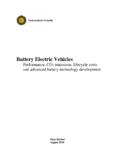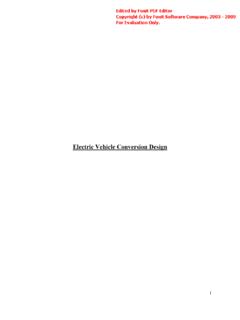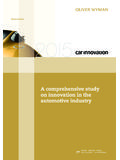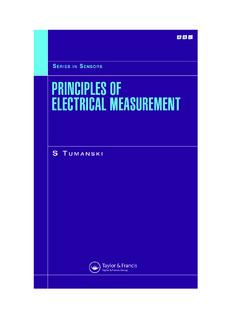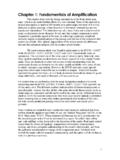Transcription of Electric Motors and Drives - ИКЕМ
1 Electric Motors and DrivesThis Page Intentionally Left BlankElectric Motors and DrivesFundamentals, Types and ApplicationsThird editionAustin HughesSenior Fellow, School of Electronic and Electrical Engineering,University of LeedsAMSTERDAM BOSTON HEIDELBERG LONDON NEW YORK OXFORDPARIS SAN DIEGO SAN FRANCISCO SINGAPORE SYDNEY TOKYON ewnes is an imprint of ElsevierNewnes is an imprint of ElsevierLinacre House, Jordan Hill, Oxford OX2 8DP30 Corporate Drive, Suite 400, Burlington, MA 01803 First edition 1990 second edition 1993 Third edition 2006 Copyright 1990, 1993, 2006, Austin Hughes. Published by Elsevier Ltd. All rights reservedThe right of Austin Hughes to be identified as the author of this workhas been asserted in accordance with the Copyright, Designs andPatents Act part of this publication may be reproduced, stored in a retrieval system or transmitted in anyform or by any means electronic, mechanical, photocopying, recording or otherwise without theprior written permission of the publisherPermissions may be sought directly from Elsevier s Science & Technology Rights Department inOxford, UK: phone (+44) (0) 1865 843830; fax (+44) (0) 1865 853333.
2 Email: Alternatively you can submit your request online by visiting the Elsevier web site at , and selecting Obtaining permission to use Elsevier materialBritish Library Cataloguing in Publication DataA catalogue record for this book is available from the British LibraryLibrary of Congress Cataloguing in Publication DataA catalogue record for this book is available from the Library of CongressISBN-13: 978-0-7506-4718-2 ISBN-10: 0-7506-4718-3 For information on all Newnes publicationsvisit our website at and bound in Great Britain0607080910 10987654321 CONTENTSP refacexvi1 Electric MOTORS1 Introduction1 Producing Rotation2 Magnetic field and magnetic flux3 Magnetic flux density4 Force on a conductor6 Magnetic Circuits7 Magnetomotive force (MMF)
3 9 Electric circuit analogy10 The air-gap11 Reluctance and air-gap flux densities12 Saturation14 Magnetic circuits in motors15 Torque Production16 Magnitude of torque18 The beauty of slotting19 Specific Loadings and Specific Output21 Specific loadings21 Torque and motor volume23 Specific output power importance of speed23 Energy Conversion Motional EMF25 Elementary motor stationary conditions26 Power relationships conductor moving atconstant speed28 Equivalent Circuit30 Motoring condition32 Behaviour with no mechanical load32 Behaviour with a mechanical load35 Relative magnitudes of V and E, and efficiency37 Analysis of primitive motor conclusions38 General Properties of Electric Motors39 Operating temperature and cooling39 Torque per unit volume40 Power per unit volume importance of speed41 Size effects specific torque and efficiency41 Efficiency and speed41 Rated voltage41 Short-term overload42 Review Questions422 POWER ELECTRONIC CONVERTERS FORMOTOR DRIVES45 Introduction45 General arrangement of drives45 Voltage Control Output from Supply47 Switching control48 Transistor chopper49 Chopper with inductive load overvoltageprotection52 Features of power electronic from Controlled Rectification55 The thyristor55 Single-pulse
4 Rectifier56 Single-phase fully controlled converter outputvoltage and control573-phase fully controlled converter62 Output voltage range64 Firing from SP SP Inversion65 Single-phase inverter65 Output voltage control67 Sinusoidal PWM683-phase inverter69vi ContentsForced and natural commutation historicalperspective69 Matrix converters70 Inverter Switching Devices72 Bipolar junction transistor (BJT)72 Metal oxide semiconductor field effecttransistor (MOSFET)73 Insulated gate bipolar transistor (IGBT)74 Gate turn-off thyristor (GTO)74 Converter Waveforms and Acoustic Noise75 Cooling of Power Switching Devices75 Thermal resistance75 Arrangement of heatsinks and forced air cooling77 Cooling fans78 Review Questions793 CONVENTIONAL MOTORS82 Introduction82 Torque Production84 Function of the commutator86 Operation of the commutator interpoles88 Motional motor Steady-State Characteristics95No-load speed95 Performance calculation example96 Behaviour when loaded98 Base speed and field weakening103 Armature reaction105 Maximum output power106 Transient Behaviour Current Surges107 Dynamic behaviour and time-constants108 Shunt.
5 Series and Compound Motors111 Shunt motor steady-state operatingcharacteristics113 Series motor steady-state operatingcharacteristics115 Contents viiUniversal motors118 Compound motors119 Four-Quadrant Operation and Regenerative Braking119 Full speed regenerative reversal122 Dynamic braking124 Toy Motors124 Review Questions1264 MOTOR DRIVES133 Introduction133 Thyristor Drives General134 Motor operation with converter supply136 Motor current waveforms136 Discontinuous current139 Converter output impedance: overlap141 Four-quadrant operation and inversion143 Single-converter reversing drives144 Double SP-converter reversing drives146 Power factor and supply effects146 Control Arrangements for Drives148 Current control150 Torque control152 Speed control152 Overall operating region154 Armature voltage feedback and IRcompensation155 Drives without current control155 Chopper-Fed Motor Drives155 Performance of chopper-fed motor drives156 Torque speed characteristics andcontrol Servo Drives159 Servo motors160 Position control162 Digitally Controlled Drives163 Review Questions164viii Contents5 INDUCTION Motors ROTATING FIELD.
6 SLIP AND TORQUE167 Introduction167 Outline of approach168 The Rotating Magnetic Field170 Production of rotating magnetic field172 Field produced by each phase winding172 Resultant field176 Direction of rotation177 Main (air-gap) flux and leakage flux177 Magnitude of rotating flux wave179 Excitation power and VA182 Summary183 Torque Production183 Rotor construction183 Slip185 Rotor induced , current and torque185 Rotor currents and torque small slip187 Rotor currents and torque large slip189 Influence of Rotor Current on Flux191 Reduction of flux by rotor current192 Stator Current-Speed Characteristics193 Review Questions1966 OPERATING CHARACTERISTICS OFINDUCTION MOTORS198 Methods of Starting Cage Motors198 Direct Starting Problems198 Star/delta (wye/mesh)
7 Starter202 Autotransformer starter202 Resistance or reactance starter203 Solid-state soft starting204 Starting using a variable-frequencyinverter206 Run-up and Stable Operating Regions206 Harmonic effects skewing208 High inertia loads overheating209 Steady-state rotor losses and efficiency209 Contents ixSteady-state stability pullout torqueand stalling210 Torque Speed Curves Influence of RotorParameters211 Cage rotor211 Double cage rotors213 Deep bar rotors214 Starting and run-up of slipring motors215 Influence of Supply Voltage on Torque Speed Curve217 Generating and Braking218 Generating region overhauling loads219 Plug reversal and plug braking220 Injection braking221 Speed Control221 Pole-changing motors222 Voltage control of high-resistance cage motors223 Speed control of wound-rotor motors224 Power Factor Control and Energy Optimisation225 Voltage control225 Slip energy recovery (wound rotor Motors )
8 227 Single-Phase Induction Motors227 Principle of operation227 Capacitor-run motors229 Split-phase motors230 Shaded-pole motors231 Size Range232 Scaling down the excitation problem232 Review Questions2337 INDUCTION MOTOR EQUIVALENT CIRCUIT236 Introduction236 Outline of approach237 Similarity Between Induction Motor and Transformer238 The Ideal Transformer240 Ideal transformer no-load condition,flux and magnetising current240x ContentsIdeal transformer no-load condition,voltage ratio245 Ideal transformer on load246 The Real Transformer248 Real transformer no-load condition,flux and magnetising current248 Real transformer leakage reactance251 Real transformer on load exactequivalent circuit252 Real transformer approximateequivalent circuit254 Measurement of parameters256 Significance of equivalent circuit parameters257 Development of the Induction Motor Equivalent Circuit258 Stationary conditions258 Modelling the electromechanicalenergy conversion process259 Properties of Induction Motors261 Power balance262 Torque262 Performance Prediction Example263 Line current264 Output power264 Efficiency265 Phasor diagram266 Approximate Equivalent Circuits267 Starting and full-load relationships268 Dependence of pull out torque onmotor
9 Parameters269 Analysis270 Graphical interpretation via phasor diagram271 Measurement of Parameters274 Equivalent circuit Under Variable-FrequencyConditions274 Review Questions277 Contents xi8 INVERTER-FED INDUCTION MOTOR DRIVES279 Introduction279 Comparison with drive280 Inverter waveforms282 Steady-state operation importance ofachieving full flux284 Torque Speed Characteristics ConstantV/f Operation286 Limitations imposed by the inverter constantpower and constant torque regions288 Limitations imposed by motor289 Control Arrangements for Inverter-Fed Drives290 Open-loop speed control291 Closed-loop speed control293 Vector (Field-Oriented) Control296 Transient torque control297 Cycloconverter Drives300 Review Questions3039 STEPPING MOTORS305 Introduction305 Open-loop position control306 Generation of step pulses and motorresponse307 High-speed running and ramping308 Principle of Motor Operation311 Variable reluctance motor312 Hybrid motor314 Summary317 Motor Characteristics318 Static torque displacement curves318 Single-stepping319 Step position error and holding torque320 Half stepping321 Step division mini-stepping323xii ContentsSteady-State Characteristics Ideal(Constant-Current)
10 Drive324 Requirements of drive324 Pull-out torque under constant-currentconditions326 Drive Circuits and Pull-Out Torque Speed Curves328 Constant-voltage drive328 Current-forced drive330 Chopper drive331 Resonances and instability333 Transient Performance335 Step response335 Starting from rest336 Optimum acceleration andclosed-loop control337 Review Questions33810
